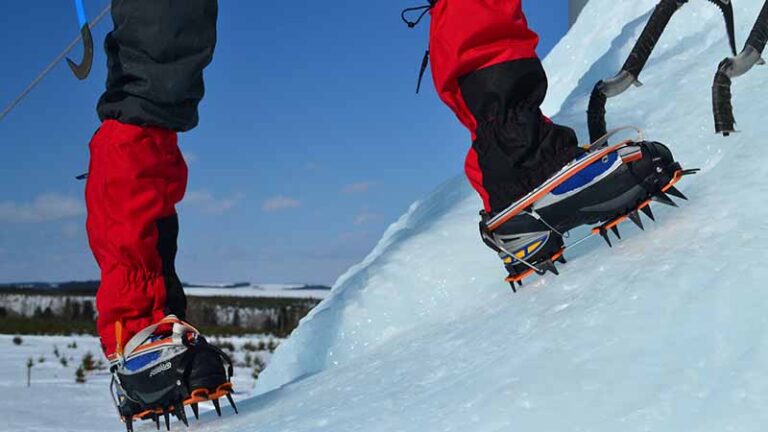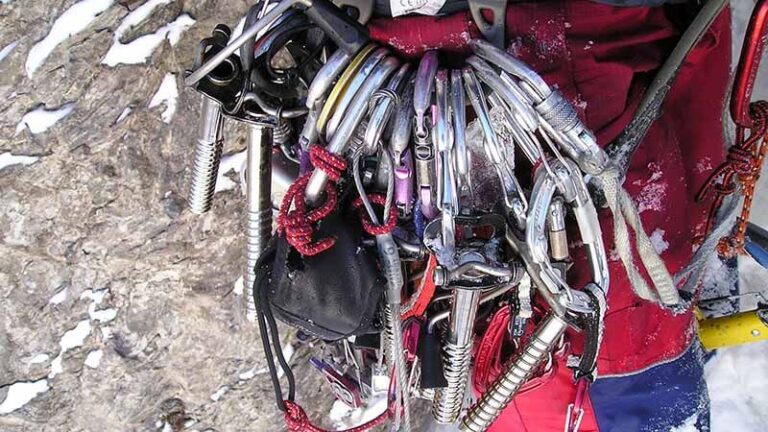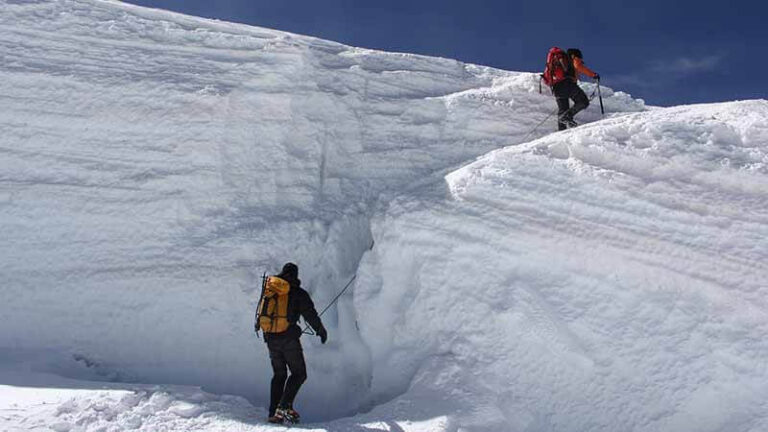Can You Ice Climb in Ski Boots?
Climbing up frozen waterfalls, ice formations, and steep ice-covered surfaces is an exciting and hard sport. Physical strength, mental endurance, and technical competence are all required. Ice climbing requires the use of specialized equipment such as ice axes, crampons, harnesses, ropes, and helmets.
Ice climbers use ice axes to create handholds on the ice and crampons to help their boots grip the ice. It is a thrilling activity that needs a great level of concentration, balance, and coordination.
The importance of having the right gear for ice climbing
Ice climbing equipment is critical for safety and success in the sport. Ice climbing equipment is designed to equip climbers with the tools they need to confront the difficult and frequently treacherous circumstances of ice climbing.
The appropriate equipment can make a big difference in terms of comfort, performance, and safety. Proper equipment can help to reduce accidents and injuries while also improving the climber’s overall experience.
Ice axes, crampons, harnesses, ropes, helmets, and specialist Ice climbing footwear are among the essential ice climbing equipment. Each piece of equipment serves a specific purpose and must be of excellent quality, well-maintained, and tailored to the needs and ability level of the climber.
While ski boots and ice climbing boots may look to be the same, they are not. They are built for various uses and have significant features. Ski boots are made to provide support and rigidity while skiing, whereas ice climbing boots are made to provide warmth, flexibility, and crampon compatibility while ice climbing.
While it is possible to ice climb in ski boots, it is not encouraged. Ski boots lack the features required for ice climbing, such as support and traction. Ski boots’ rigid design makes keeping good foot placement and balance on ice surfaces difficult. Furthermore, ski boots may not be sufficiently insulated to keep climbers’ feet warm in cold temperatures, increasing the risk of frostbite and other cold-related injuries.
What are ski boots?
Ski boots are a form of footwear created exclusively for skiing. They have a rigid plastic shell with a soft foam liner that molds to the curve of the skier’s foot. Ski boots are designed to give the skier with support and stability, allowing for perfect control of the ski. They also help to transmit power from the skier’s body to the ski, making it easier to turn and stop.
Components of ski boots
Ski boots are made up of various parts, each of which serves a distinct purpose. These elements are as follows:
- Outer shell – The outer shell is constructed of solid plastic and serves as the ski boot’s structure and support. It covers the skier’s foot and ankle while also acting as a platform for the skier’s movements.
- Liner – Made of soft foam, the liner molds to the curve of the skier’s foot, giving comfort and support. It keeps the foot in place inside the boot and absorbs shock and vibration.
- Buckles – The buckles secure the ski boot to the foot. They are usually composed of metal and have adjustable tension to guarantee a secure fit.
- Power strap – A Velcro strap that provides additional support and aids in keeping the foot in position inside the boot.
Types of ski boots
Several ski boots are available for various skiing types and skill levels. The following are the most prevalent varieties of ski boots:
- Alpine boots – Alpine boots are downhill skiing boots. They’re stiff and provide a lot of support and control, so they’re great for advanced skiers.
- Nordic boots – Nordic boots are cross-country skiing boots. They are lightweight and flexible, giving the skier comfort and freedom of mobility.
- Freestyle boots – Park and pipe skiing require freestyle boots. They are flexible and have a wide range of motion, which allows for tricks and jumps.
- Touring boots – These boots are made for backcountry skiing. They are lightweight and flexible, with a hiking mode that makes walking and climbing simpler.
Ice climbing boots
Ice climbing boots are a form of footwear made specifically for ice climbing. They are waterproof and built of insulating materials to protect the feet from the cold and wet conditions faced while ice climbing. Crampons, which are spiked inserts that attach to the bottom of the boots and offer traction on the ice, are meant to be compatible with Ice climbing boots.
Components of ice climbing boots
Ice climbing boots are made up of various components, each of which is designed to perform a distinct job. These elements are as follows:
- Outer shell – The outer shell, which is constructed of stiff plastic or synthetic material, offers structure and support for the ice climbing boot. It covers the climber’s foot and ankle while also serving as a platform for his or her actions.
- Insulation – The insulation is constructed of materials that give warmth and moisture protection, such as Thinsulate, Gore-Tex, or PrimaLoft. They are made to keep your feet warm and dry in cold and damp weather.
- Insole – The insole is the component of the boot that cushions and supports the foot. It absorbs shock and ensures a comfortable fit for the foot.
- Crampon attachment – A crampon attachment is a metal bar on the bottom of the boot that permits crampons to be attached. It gives traction on the ice and ensures safe footing.
Types of ice climbing boots
Ice climbing boots are available in a variety of styles and materials to suit a variety of climbing styles and circumstances. The following are the most prevalent varieties of ice climbing boots:
- Single boots are intended for general mountaineering and ice climbing. They are stiff and provide optimum support and control, making them excellent for intermediate and experienced climbers.
- Double boots – Double boots are suited for high-altitude climbing and extreme cold weather. They are made up of an inner and outer boot for optimal insulation and warmth.
- Mixed climbing boots – Mixed climbing boots are made for mixed terrain climbing, which includes rock and ice climbing. They are lightweight and flexible, allowing the climber to move freely and comfortably.
Differences between ski boots and ice climbing boots
Ski boots and ice climbing boots are both built for specialized sports and activities and have major design and construction variances. In this part, we’ll go over some of the key distinctions between ski boots and Ice climbing boots.
Support and stiffness
Ski boots are designed to provide the foot and ankle with the essential support and stiffness for skiing. The boots are stiff and give a sturdy foundation for the skier to handle and balance their skis. Ice climbing boots, on the other hand, are stiff as well, but they are meant to provide support and stability while climbing on steep and icy terrain.
Crampon compatibility
Crampons are an essential element of ice climbing equipment, giving traction and hold on the ice. Ice climbing boots are specifically built to be crampon-compatible, having a metal bar on the bottom of the boot that allows the crampon to be securely connected. Ski boots are not intended for use with crampons, and their bottoms are not ideal for ice climbing.
Insulation and warmth
Ice climbing is done in cold and damp conditions, hence ice climbing boots are made to provide the most insulation and warmth to the feet. To keep the feet warm and dry, they are made of insulated materials such as Thinsulate, Gore-Tex, or PrimaLoft. Ski boots are likewise intended to keep your feet warm, but they are not normally waterproof.
Weight
Ski boots are often heavier than ice climbing boots because they are intended to provide a great deal of support and stiffness to the foot and ankle. Ice climbing boots are lightweight and agile, allowing the climber more flexibility of movement.
Flexibility
Ski boots are made to be stiff and give a sturdy foundation for skiing. Ice climbing boots, on the other hand, are meant to be more flexible, allowing the climber more flexibility of movement while climbing.
Can you ice climb in ski boots?
Ski boots are not meant for ice climbing, and using them for this purpose can be hazardous. Some people may still contemplate utilizing ski boots for ice climbing, so let’s look at the benefits and drawbacks of doing so.
Advantages of using ski boots for ice climbing
- Availability: If you already own a pair of ski boots, you may be tempted to use them for ice climbing instead of purchasing new ice climbing boots.
- Rigidity: Ski boots are firm and give a stable platform for the foot and ankle, which can be useful when ascending on steep ice.
- Cost: Because ski boots are less expensive than ice climbing boots, they may be a more economical option for some.
Disadvantages of using ski boots for ice climbing
- Incompatibility with crampons: Ski boots are not designed to be worn with crampons, which are required for ice climbing. Without crampons, gaining a grip on the ice is difficult, and climbing becomes considerably more risky.
- Inadequate warmth: Ski boots are not meant to give warmth in wet and cold situations, which can be uncomfortable and even dangerous when ice climbing.
- Flexibility: Ski boots are designed to be stiff, which can limit foot and ankle flexibility, making it more difficult to ascend over uneven and snowy terrain.
Risks and dangers of using ski boots for ice climbing
- Inadequate support: Ski boots do not give the same level of support and stability as ice climbing boots, increasing the risk of injury while climbing.
- Slippery risk: Ski boots do not have the same level of ice traction as Ice climbing boots, which increases the risk of slipping and falling.
- Frostbite danger: Ski boots are not designed to provide warmth and insulation in wet and freezing circumstances, increasing the risk of frostbite and other cold-related injuries.
Conclusion
The key distinctions between ski boots and ice climbing boots are support and stiffness, crampon compatibility, insulation, warmth, weight, and flexibility. Due to the lack of crampon compatibility, warmth, and flexibility, as well as the greater danger of slipping, frostbite, and other cold-related problems, ski boots are not advised for ice climbing.
In response to the question, while ice climbing in ski boots is technically possible, it is not recommended owing to the hazards and dangers involved. Ice climbing boots are specially developed to provide support, traction, and warmth in icy and cold conditions, all of which are required for safe and pleasurable ice climbing.
Ice climbers must select the appropriate equipment for the sport. Investing in a solid pair of ice climbing boots that give support, warmth, and crampon compatibility is part of this. It is also critical to select the appropriate crampons and ice axes for the terrain and conditions of the climb. Finally, ice climbers should always emphasize safety and use equipment specifically intended for ice climbing to reduce the risks and dangers associated.







